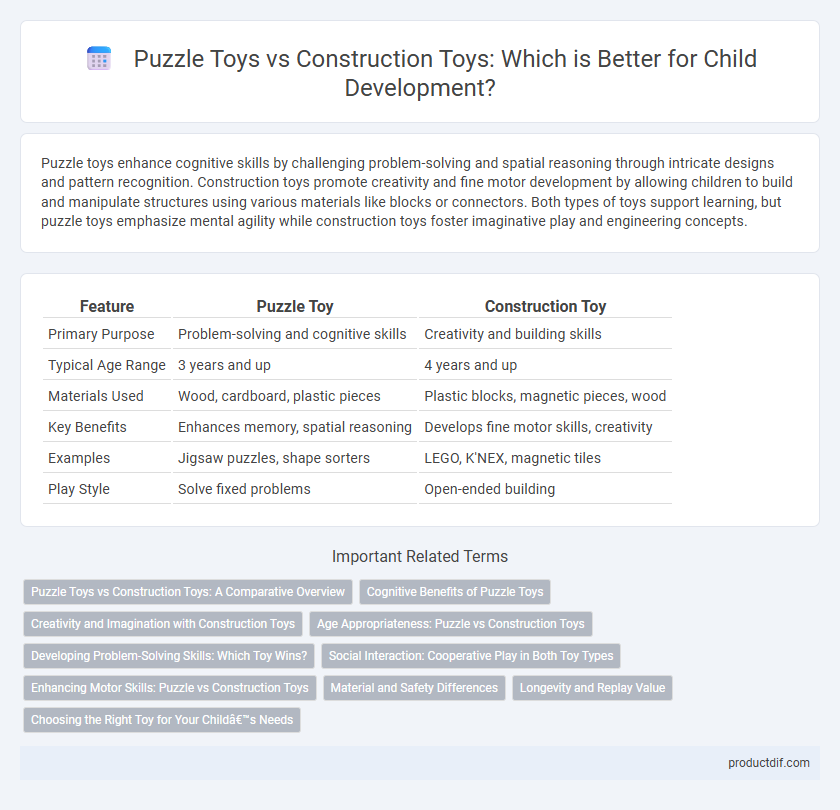Puzzle toys enhance cognitive skills by challenging problem-solving and spatial reasoning through intricate designs and pattern recognition. Construction toys promote creativity and fine motor development by allowing children to build and manipulate structures using various materials like blocks or connectors. Both types of toys support learning, but puzzle toys emphasize mental agility while construction toys foster imaginative play and engineering concepts.
Table of Comparison
| Feature | Puzzle Toy | Construction Toy |
|---|---|---|
| Primary Purpose | Problem-solving and cognitive skills | Creativity and building skills |
| Typical Age Range | 3 years and up | 4 years and up |
| Materials Used | Wood, cardboard, plastic pieces | Plastic blocks, magnetic pieces, wood |
| Key Benefits | Enhances memory, spatial reasoning | Develops fine motor skills, creativity |
| Examples | Jigsaw puzzles, shape sorters | LEGO, K'NEX, magnetic tiles |
| Play Style | Solve fixed problems | Open-ended building |
Puzzle Toys vs Construction Toys: A Comparative Overview
Puzzle toys enhance cognitive skills by challenging problem-solving and spatial reasoning, promoting mental agility in children and adults alike. Construction toys foster creativity and fine motor development through hands-on assembly and imaginative play, supporting STEM learning and teamwork. Both toy types contribute uniquely to child development by encouraging critical thinking and dexterity in engaging, interactive ways.
Cognitive Benefits of Puzzle Toys
Puzzle toys enhance cognitive development by improving problem-solving skills, spatial reasoning, and memory retention in children. Unlike construction toys, which primarily encourage creativity and fine motor skills, puzzle toys require focused attention and logical thinking to complete complex patterns and sequences. These cognitive challenges foster mental flexibility and concentration, essential for academic success and lifelong learning.
Creativity and Imagination with Construction Toys
Construction toys significantly enhance creativity and imagination by allowing children to design and build unique structures, fostering problem-solving skills and spatial awareness. Unlike puzzle toys, which primarily focus on fitting predetermined pieces together, construction toys encourage open-ended play and experimentation with different shapes, sizes, and colors. Building blocks, magnetic sets, and interlocking bricks stimulate innovative thinking and provide endless possibilities for creative expression.
Age Appropriateness: Puzzle vs Construction Toys
Puzzle toys are generally designed for younger children aged 2 to 6 years, enhancing cognitive skills and problem-solving with simple shapes and increasing complexity as they grow. Construction toys cater to a broader age range, typically from 3 years to adolescence, promoting spatial awareness, creativity, and fine motor skills through building blocks and interlocking pieces. Age-appropriate selection ensures safety and developmental benefits, with puzzles focusing on pattern recognition and construction toys supporting engineering and imaginative play skills.
Developing Problem-Solving Skills: Which Toy Wins?
Puzzle toys enhance problem-solving skills by encouraging critical thinking, pattern recognition, and logical reasoning through focused challenges. Construction toys develop creativity and spatial awareness by allowing children to build complex structures, promoting trial-and-error learning and fine motor skills. Puzzle toys typically provide more direct cognitive problem-solving benefits, while construction toys foster broader imaginative problem-solving abilities.
Social Interaction: Cooperative Play in Both Toy Types
Puzzle toys and construction toys both enhance social interaction through cooperative play by encouraging teamwork and problem-solving among children. Puzzle toys require players to communicate and collaborate to fit pieces correctly, promoting cognitive development and shared goals. Construction toys foster joint creativity and negotiation as children build structures together, strengthening social bonds and cooperative skills.
Enhancing Motor Skills: Puzzle vs Construction Toys
Puzzle toys enhance fine motor skills through precise hand-eye coordination and finger dexterity required to fit pieces together, promoting cognitive development and spatial reasoning. Construction toys develop gross motor skills and hand strength by encouraging children to manipulate larger components, fostering creativity and problem-solving abilities. Both toy types contribute to motor skill enhancement but target different physical abilities and developmental benefits.
Material and Safety Differences
Puzzle toys are typically made from non-toxic, durable cardboard or wood with smooth edges to ensure child safety and reduce choking hazards. Construction toys often use high-quality, BPA-free plastic or wood designed to withstand rough play while featuring interlocking pieces that minimize accidental swallowing. Both types prioritize non-toxic finishes and compliance with international safety standards, but construction toys generally require more robust materials to support complex structures.
Longevity and Replay Value
Puzzle toys offer high replay value through cognitive challenges that evolve as children develop problem-solving skills, ensuring long-term engagement. Construction toys provide exceptional longevity by encouraging creativity and the continuous building of new structures, supporting open-ended play over time. Both toy types promote sustained interest but differ in how they stimulate mental growth and imaginative exploration.
Choosing the Right Toy for Your Child’s Needs
Puzzle toys enhance a child's cognitive skills, problem-solving abilities, and fine motor coordination by encouraging pattern recognition and logical thinking. Construction toys foster creativity, spatial awareness, and engineering skills through hands-on building and imaginative play. Selecting the right toy depends on your child's developmental stage and interests, with puzzles suited for refining critical thinking and construction sets ideal for boosting creativity and spatial reasoning.
Puzzle toy vs Construction toy Infographic

 productdif.com
productdif.com